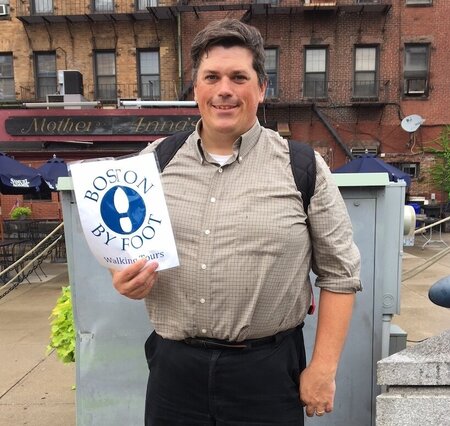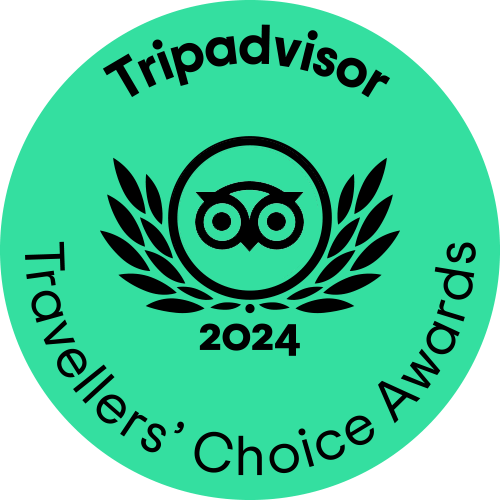
Liam Sullivan
Seasoned veteran guide Liam Sullivan has been with Boston By Foot for 18 years. Prior to joining us up north in Boston, Liam worked as an historical interpreter down south in Colonial Williamsburg, Virginia. Though he is currently focused on our Dark Side of Boston tour and our Tours of the Month, his impressive repertoire of past-guided tours includes the North End, Boston By Little Feet, Road to Revolution, Historic Waterfront, and Reinventing Boston: A City Engineered.
What attracted you to Boston By Foot/being a tour guide?
Having worked in a history museum I missed being able to talk with the public about my passion for history. I also love learning and sharing new things about Boston. Might as well make it a hobby.
Did you have any background in history/architecture before joining BBF?
At Colonial Williamsburg, I led tours of 7 different buildings: the Capitol, the Public Gaol, the Governor’s Palace, the George Wythe House, the Peyton Randolph House, Wetherburn’s Tavern, and Raleigh Tavern. Tours lasted 15-30 minutes and I could lead up to 6 tours per day. Being inside had the advantage over Boston By Foot tours in that I didn’t have to compete with all the noise of a busy city. I also had to wear 18th-century styleclothing, and I’m much happier wearing my own comfortable clothing on a BBF tour. A Colonial Williamsburg tour was limited to moving from room to room in the building without much space to personalize the tour. And if you talked too long, you could get “rattled” (literally the guide with the next group shaking the door knob to tell you to move on). BBF has a 90-minute limit, but a lot more space to use the tour manual as a jumping off space for where you’re going to stand at each stop with your group and what you’re going to talk about and you get to really flesh things out more. There were a fair share of people who went to Colonial Williamsburg who weren’t particularly interested in the tour, either they felt obligated to visit because it’s a famous American historical site or were dragged along by family, but almost always on BBF tours the tourees are people who are eager and interested in learning about the city, so that makes it more relaxing and easier to engage with people.
What’s your favorite tour to give and why?
North End, because so much happened in such a small space and I can talk about the social history of the many people who lived there. I have always been interested in social history and on most tours it’s easy to get bogged down in architectural details and lose track of the people who lived there. On the North End tour as well as the Dark Side of Boston, the stories of people take primacy. And the people who lived there may not have been prominent but left their mark. It’s fun to show people the signs of Boston’s Jewish immigrant community in the faded markings of a synagogue and Hebrew School. Or to discuss why there are three Catholic churches within about 2 blocks of one another and open up an understanding of the splits between Irish and Italian immigrants and even within different groups of Italian-Americans. The Dark Side tour is just amazing in that we can talk about all of these events – anarchist bombings, influenza, Charles Ponzi’s scheme, the molasses flood, and the funeral of Sacco & Vanzetti – and they all happened in one dense but tiny neighborhood in a short period of time.
What is your favorite tour memory to date?
A long time ago on a Boston Underground tour, now known as “Reinventing Boston: A City Engineered,” when I showed tourees the hidden signs that said "Scollay Square" a touree launched into singing the song "Charlie and the MTA.”
What’s your favorite building in Boston and why?
Boston Public Library, a true palace of the people. The epic architecture, especially of the McKim building, is usually reserved for the wealthy and elite, but at the BPL, it’s “Free to All.” A place where anyone can go study, work on a computer for a while, or get a lunch in the beautiful courtyard.
What is something that tour groups are surprised to learn about Boston or its history?
The ubiquity of Dunkin' Donuts.
Tell us a bit about August’s tour of the month of SoWa.
I was recruited for the SoWa tour by my co-lead guide Gretchen Grozier. It was a part of town I knew absolutely nothing about before starting to research the tour (I think a lot of people will not know much about the area when coming on the tour). I like learning about new-to-me places in Boston by researching for the tours. Like the North End, the area South of Washington was home to many immigrant and working class people, but much of the area ended up being obliterated by urban renewal in the mid-20th century. Some things managed to survive and have been creatively adapted for the area’s new identity as the SoWa Art District. A massive power station was built for the first city-wide electric trolley network in the 1890s but became obsolete in less than two decades and then was basically abandoned. Today it’s used as a large venue for special events. Thousands of people in 19th century Boston were employed at piano factories and we’ll see one springing factory building now being used for a swanky restaurant and office space. The Bates School, built for the children of working class immigrants in an elegant style to promote civic pride (not unlike the BPL), is now the center of an ArtsBlock where artists are able to get affordable living and studio spaces. It’s going to be fun showing people these lost bits of Boston’s past that somehow survived and ended up being used entirely different from the original purpose.

